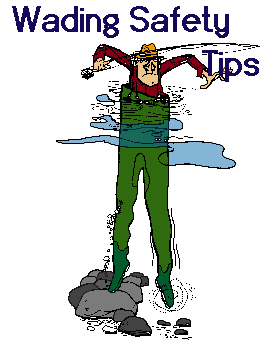

 Lee Wulff, where are you? If memory serves, it was in the 40's that Wulff
tried to eradicate the myth of getting trapped by the air in your waders and
drowning: he jumped off a bridge in February into 30 feet of water, wearing
his waders. He did not get flipped by the trapped air in his feet; he did
not drown--he simply swam to shore.
Lee Wulff, where are you? If memory serves, it was in the 40's that Wulff
tried to eradicate the myth of getting trapped by the air in your waders and
drowning: he jumped off a bridge in February into 30 feet of water, wearing
his waders. He did not get flipped by the trapped air in his feet; he did
not drown--he simply swam to shore.What does this mean today if you get dunked? If you are wearing the older voluminous waders, wear a belt: it helps keep the water out, so you stay drier. Do not, repeat NOT, entertain notions of using that nifty stainless serrated-edged knife to cut off your boots. You'll ruin the waders and quite possibly hurt yourself. In any case, you don't want to be curled up sawing at your feet, you want to be on your back with your feet out ahead of you.
You say you're wearing neoprenes? Good, for in effect you are wearing a farmer john wet-suit that should help insulate you against the shock of the cold water.
In any case, the technique is the same: get on your back with your feet downstream, ready to push off any obstacles, while you go with the flow, looking to where you might edge to shore.
But what about that big rock ahead? The one sticking up out of the water? Shouldn't be a problem: notice how the water divides around it? Figure out which way you want to go around it and position yourself accordingly. But what about those standing waves? Rather fun, actually.
Are you telling me everything's OK? No. You do need to watch out for anything across the stream, like a fallen tree, that can trap you and drown you. Short of that, or a waterfall, you should be OK. Obviously, an ounce of prevention is helpful: don't try to wade just above such a hazard.
Prevention is really the key. Some suggestions:-
If you consistently fish big water, you might this summer want to try throwing yourself in on purpose. I had to do this for a white-water canoeing class. Like any good educational experience, it turned out to be fun slipping by those big rocks and relaxing through the standing waves. Have a friend or two there, and have dry clothes handy, of course. You don't want to survive a dunk in the river only to die of hypothermia on shore.
May you wade well, and long,
Gerry